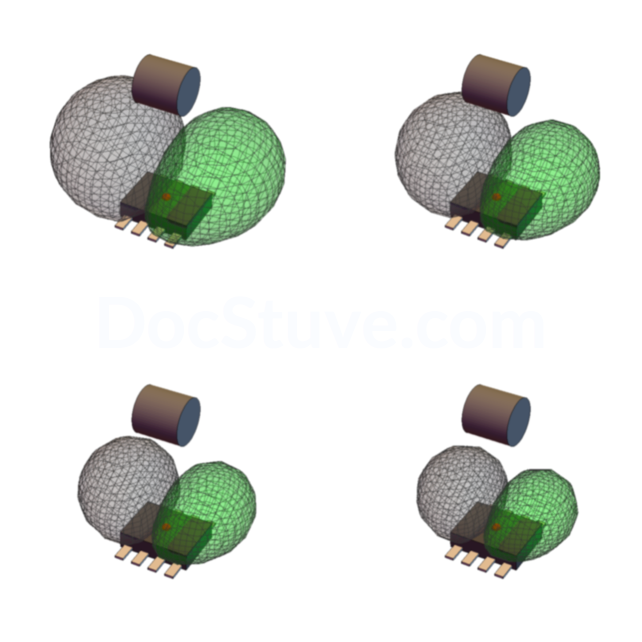Intro to Hall-Effect Latches
What is a Hall-effect Latch?
A Hall-effect latch is a device that is activated by one pole of a magnet and deactivated by the other. In many types of latches, the south pole activate the latch and the north pole deactivates. Once the latch has been activated or deactivated, it stays in the same electrical state until the other magnet pole is brought near.
A typical use of latches is having alternating magnet poles pass by the latch. This might be a single rotating magnet, a magnet will several alternating poles, or multiple magnets.
Hall-Effect Latch Activation Patterns
Transition Region for Hall-Effect Latch With Magnet Facing Latch
This set of images show different views of the transition region for a latch. This will look the same for either pole of the magnet.
- When the magnet enters the green region, the latch will change states.
- When one magnet pole is brought near, the latch will activate.
- When the other magnet pole is brought near, the latch will deactivate.
- When the magnet is outside the green region, the latch stays in its current state.
Many types of latches use a south pole to turn on and a north pole to turn off. You do need to read the data sheet to make sure how a particular latch operates.
Transition Regions for MAGNET PARALLEL TO HALL-EFFECT Latch
This set of images show different views of the activated and deactivated regions around a latch when the magnet is parallel to the switch.
- Latch On: magnet inside the green region
- Latch off: magnet inside the gray region.
- Hysteresis: magnet outside of green and gray regions.
Once a latch is on or off, the magnet must be moved to the other transition region to change the state.
The red dots on the magnet and switch show the reference points for positioning.
How does a latch respond to a magnetic field?
You need to keep track of three things when working with a Hall-effect latch. You must read the data sheet for a particular latch to learn the details.
- Direction of Magnetic Field: the latch is polarity sensitive. One pole turns it on; the other turns it off.
- Strength of Magnetic Field: the latch turns on and off at particular field strength levels.
- Operating Tolerances of Switch: the strength levels differ for each latch due to natural manufacturing variation as well as environmental factors.
Many types of latches are activated when the field points from back to front. This can be achieve by a south pole near the face or a north pole near the back. These types of latches are deactivated by a field pointing the opposite direct.
Be sure to read the data sheet to understand which direction must be used.
SWITCH REQUIREMENTS FOR MAGNETIC FIELD STRENGTH
Different models of latches respond to different field strengths. Some are more sensitive than others. The images to the left show the effect of using the same magnet with different models of latches
More sensitive latches have larger transition regions. Less sensitive latches have smaller transition regions. Your particular application will determine what model of latch would be most appropriate.
THE EFFECT OF MAGNET AND SENSOR TOLERANCES
It is very important to keep track of magnet and sensor tolerances.
The left image shows the response to "typical" magnet and sensor parameters. In practice, this is probably close to what would be observed when constructing prototypes.
The right image shows the possible range of operation across magnet and sensor tolerances. Somewhere in the region between the darker and lighter areas is where all magnet and sensor combinations would be expected to transition. Most will be near the "typical" regions. However, some statistical fraction of combinations would be nearer the inner or outer regions.
Key Things You Need to Know
- A Hall-effect latch is not like a mechanical switch. It is a powered device. Its "on" and "off" states can be voltage, current, or PWM states.
- The operation of the latch depends on the magnet design you use.
- Latches are polarity sensitive. One magnet pole turns them on. The other pole turns them off.
- The operating patterns depend on magnet orientation.
- The operating patterns depend on magnet strength and size.
- The operating patterns depend on the latch response to the field.
- Individual latches and magnets have production and operation tolerances. You must account for these!
- You MUST read the data sheet to learn the magnetic, electrical, and mechanical properties of the latch you are using.



